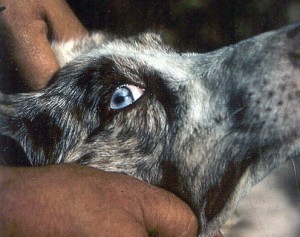
Iris coloboma occurs when part of the iris fails to develop. Colobomas may be only small notches out of the inner edge of the iris, pie slices, or massive holes – occasionally so large it appears the dog has no iris at all. This condition is present at birth and in most cases the effect on vision is minimal. However a large coloboma can force a dog to squint in bright light because the iris is incapable of contracting properly to reduce the amount of light entering the eye. This can cause minor discomfort as well as temporarily reducing the range of vision, which could impact performance or work.
Iris colobomas are generally detected during an ophthalmologic exam, but some may be noted by small animal veterinarians or noticed by the owner. If the dog is being presented to a veterinary ophthalmologist the irises must be examined before dilation. Some small colobomas may not be apparent when the eye is dilated and thus missed. The American College of Veterinary Ophthalmologists (ACVO) recommends that Australian Shepherds’ irises be examined prior to dilation.
The mode of inheritance for iris coloboma is unknown. Almost all iris colobomas in Aussies were seen in merle dogs, however they will occasionally be found in non-merles. The reason for the high association with merles is not known. It is very possible that non-merles with normal irises might carry the genes. Affected animals should not be bred. Normal dogs which produce IC should be bred to mates with little or no family history of IC.
Some dogs are diagnosed with iris hypoplasia. This is a thinning of the iris tissue. Whether it is a milder expression of the same process that produces IC ic not known. It does not impact vision but should be considered faulty for breeding purposes. Dogs that have iris hypoplasia may be bred, but should only be mated to dogs that don’t have the condition and, to be safe, also don’t have recent family history of IC.
